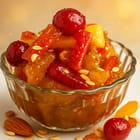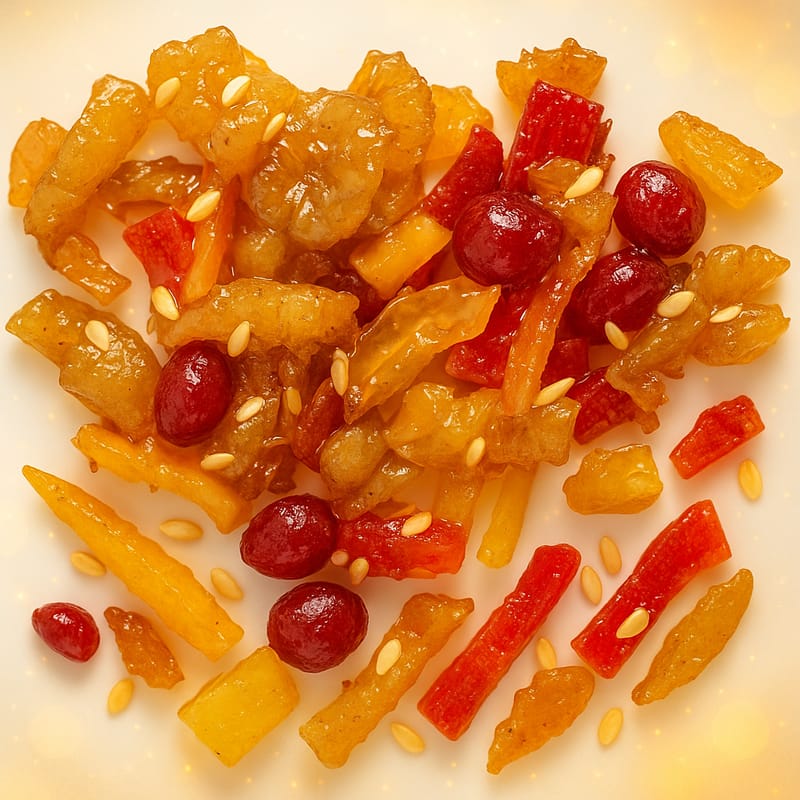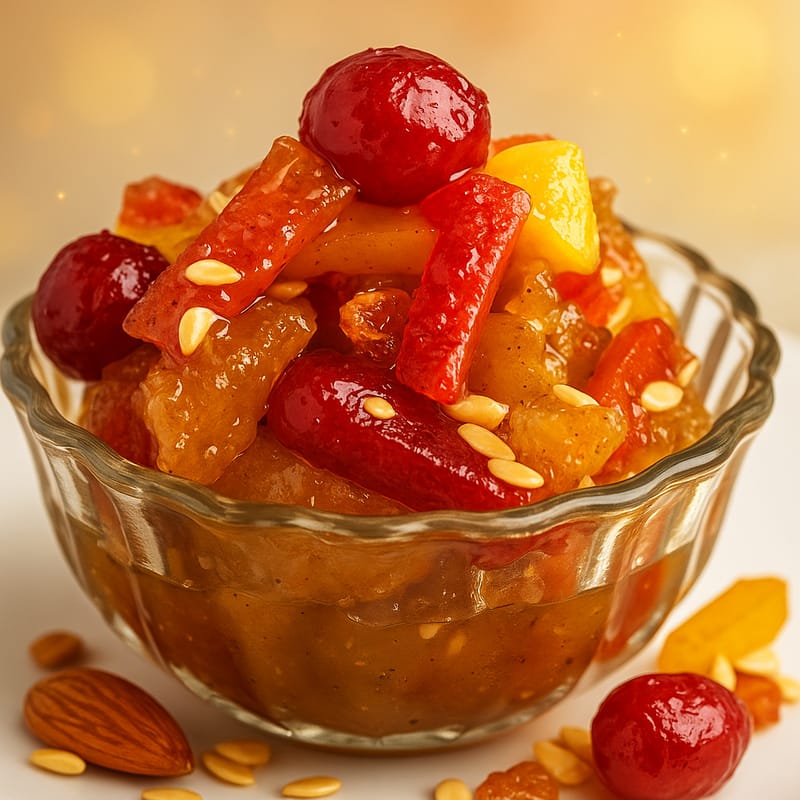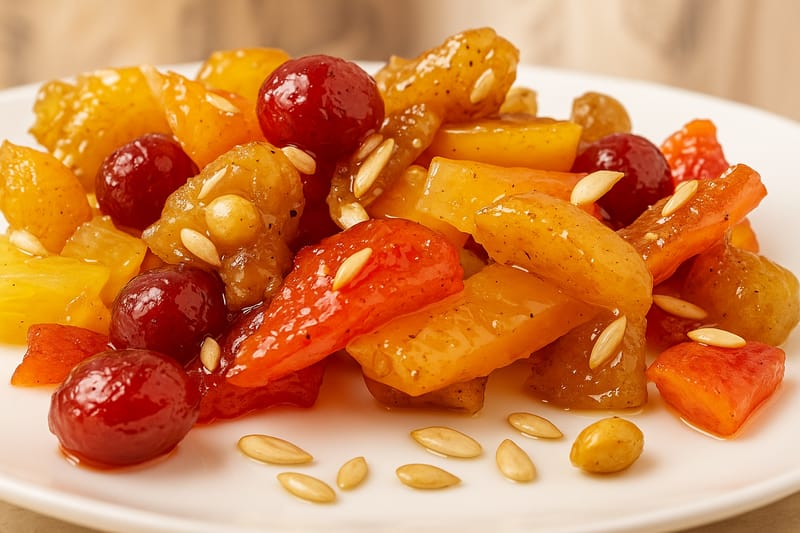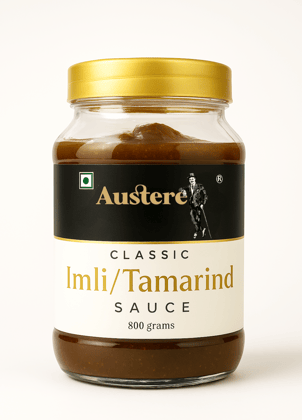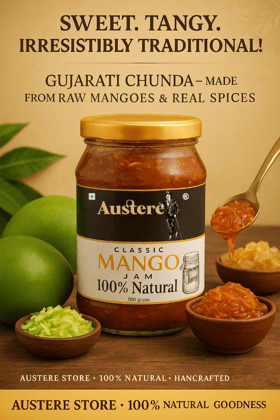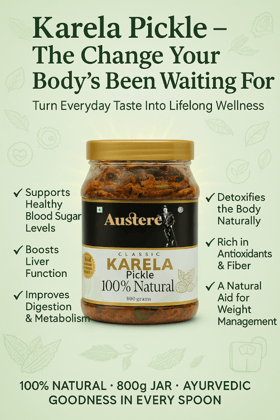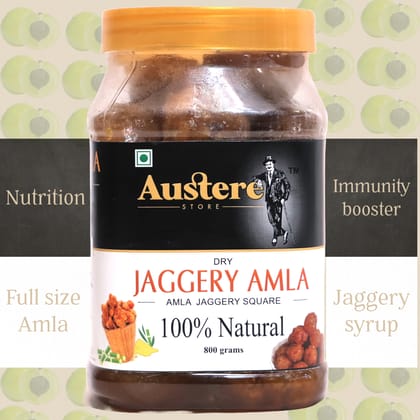Ingredients:
- Fruits and Vegetables: Common fruits and vegetables used in mixed murabba include amla (Indian gooseberry), mango, apple, papaya, orange peel, carrot, and more. The selection...
Key Attributes
| Country of origin | India |
|---|---|
| Brand | AUSTERE STORE |
| Net Quantity | 800 gram |
| Product Dimensions | 12L x 12W x 12H cm |
Ingredients:
- Fruits and Vegetables: Common fruits and vegetables used in mixed murabba include amla (Indian gooseberry), mango, apple, papaya, orange peel, carrot, and more. The selection depends on regional preferences and availability.
Sweetness and Tanginess:
- Sugar Syrup: The fruits or vegetables are preserved in a sugar syrup, imparting sweetness to the murabba.
- Natural Tartness: Some fruits, like amla or certain citrus peels, contribute a natural tartness, balancing the sweetness of the sugar syrup.
Spices:
- Spice Infusion: Mixed murabba may include spices such as cinnamon, cloves, cardamom, or others. These spices add warmth and depth to the flavor profile.
Texture:
- Variety: The combination of different fruits and vegetables creates a diverse texture in mixed murabba, ranging from the firmness of apples to the softer texture of cooked peels.
Culinary Uses:
- Condiment: Mixed murabba can be enjoyed as a condiment, accompanying meals or snacks.
- Toppings: It can be used as a topping for desserts, yogurt, or ice cream.
- Spread: Mixed murabba is sometimes spread on bread or toast.
Nutritional Content:
- Vitamins and Minerals: The variety of fruits and vegetables used in mixed murabba contribute to its nutritional content, providing vitamins, minerals, and antioxidants.
Traditional and Cultural Significance:
- Festivals: Murabba-making is often associated with festive occasions and celebrations.
- Preservation Technique: Historically, murabba was a method of preserving seasonal fruits and vegetables for consumption during off-seasons.
Homemade vs. Commercial:
- Customization: Homemade mixed murabba allows for customization of ingredients and spice levels. Commercial versions may have variations in ingredients and preservatives.
| Country of origin | India |
|---|---|
| Brand | AUSTERE STORE |
| Net Quantity | 800 gram |
| Additive info | Preservatives: Sodium Benzoate: Sodium benzoate is a commonly used preservative that helps inhibit the growth of microorganisms and extends the shelf life of the murabba. Acidity Regulators: Citric Acid: Citric acid is a natural acid found in citrus fruits and is used as an acidity regulator. It can contribute to the tanginess of the murabba. Coloring Agents: Natural Colors or Artificial Colors: While natural colors from the fruits are often sufficient, some products might use additional natural or artificial colors to enhance or standardize the appearance. Flavor Enhancers: Artificial Flavors or Natural Flavors: Flavor enhancers may be used to enhance the overall taste and aroma of the murabba. Emulsifiers or Stabilizers: Pectin: Pectin is a natural thickening agent found in fruits. It may be added to improve the texture and consistency of the murabba. Antioxidants: Ascorbic Acid (Vitamin C): Ascorbic acid may be added as an antioxidant to prevent oxidation and maintain the color and freshness of the murabba. Sweeteners: Additional Sugar or Sweeteners: Some recipes may include additional sugar or sweeteners to enhance the sweetness of the murabba. |
| Batch number | A4 |
| Expiry Date | 10 MONTHS |
| Weight | 850 g |
| Package Dimension | 12L x 12W x 12H cm |
| Product Dimensions | 12L x 12W x 12H cm |
| Food type | veg |
| Ingredients | Ingredients: Assorted fruits (such as apples, pears, peaches, apricots, plums, etc.), peeled and diced Sugar Water Lemon juice Spices (optional, such as cardamom, cinnamon, or cloves) |
| Nutritional information | -Calories: The calorie content can vary, but it's generally in the range of 30 to 50 calories per serving. -Carbohydrates:Total Carbohydrates: Around 7 to 12 grams per serving. -Sugars: The sugar content can vary based on the fruits and the amount of added sugar. -Dietary Fiber:The fiber content can range from 1 to 2 grams per serving, depending on the fruits used. -Vitamins:The mixed fruits in murabba may contribute to the vitamin content, including vitamin C and various B vitamins. -Minerals:Depending on the fruits and the recipe, murabba may contain small amounts of minerals such as potassium, calcium, and iron. |
| Instructions | Ingredients: Assorted fruits (e.g., apple, pear, peach, apricot), peeled and chopped Sugar Water Lemon juice Spices (e.g., cardamom, cinnamon), optional Instructions: Prepare the Fruits: Wash, peel, and chop the assorted fruits into bite-sized pieces. Ensure that the fruits are ripe but not overly soft. Create Sugar Syrup: In a large pan, combine sugar and water to create a sugar syrup. The ratio of sugar to water can vary based on your sweetness preference. Boil the Syrup: Bring the sugar syrup to a boil over medium heat. Stir to dissolve the sugar completely. Add Lemon Juice: Add a splash of fresh lemon juice to the sugar syrup. Lemon juice helps prevent the fruits from darkening and adds a hint of tartness. Add Fruits to Syrup: Once the sugar syrup is ready, add the chopped fruits to the pan. Stir gently to ensure all fruits are coated in the syrup. Cook the Fruits: Simmer the fruits in the sugar syrup over low to medium heat. The cooking time will depend on the fruits used. Cook until the fruits become tender but not mushy. Optional Spices: If desired, add spices such as cardamom or cinnamon for flavor. Adjust the quantity based on your taste preferences. Check for Consistency: Check the consistency of the syrup. It should be thickened and glossy. The murabba is ready when the fruits are cooked, and the syrup has reached the desired thickness. Cooling Period: Allow the mixed murabba to cool to room temperature. The syrup will thicken further as it cools. Store: Transfer the mixed murabba to sterilized glass jars. Ensure the jars are airtight. Maturation Period: Allow the murabba to mature by storing it in a cool, dark place for a few days to a couple of weeks. This allows the flavors to meld and intensify. Serve and Enjoy: Once matured, the mixed murabba is ready to be served as a sweet and flavorful accompaniment to meals or snacks. |
| contact details consumer care | AUSTERE STORE, [email protected] |








